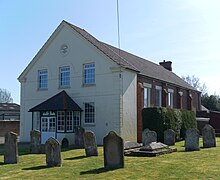Zoar Strict Baptist Chapel
| Zoar Strict Baptist Chapel | |
|---|---|

The chapel from the northwest
|
|
| 50°52′44″N 0°13′37″E / 50.8790°N 0.2270°ECoordinates: 50°52′44″N 0°13′37″E / 50.8790°N 0.2270°E | |
| Location | A22, Lower Dicker, near Hailsham, East Sussex BN27 4AT |
| Country | United Kingdom |
| Denomination | Baptist |
| Tradition | Strict Baptist |
| History | |
| Former name(s) | The Dicker Chapel |
| Founded | 1837 |
| Founder(s) | William Cowper |
| Architecture | |
| Status | Chapel |
| Functional status | Active |
| Style | Classical/Georgian |
| Groundbreaking | 1837 |
| Completed | 1838 |
| Construction cost | £422 |
Zoar Strict Baptist Chapel is a Strict Baptist place of worship in the hamlet of Lower Dicker in the English county of East Sussex. Founded in 1837 and originally known as The Dicker Chapel, the "large and impressive"Classical/Georgian-style building stands back from a main road in a rural part of East Sussex. The 800-capacity building included a schoolroom and stables when built, and various links exist between people and pastors associated with the chapel and other Strict Baptist and Calvinistic causes in the county, which is "particularly well endowed with [such] chapels".
The chapel was built in 1837–38 and substantially extended in 1874. It has its own burial ground, extended in 1880. After a brief attempt by the first pastor to run the chapel along mixed denominational lines—serving Strict Baptist and Calvinistic Independent worshippers—it assumed a solely Strict Baptist identity, which it retains as of 2017. Six permanent pastors have administered the chapel during its existence: one served for more than 50 years.
The name Dicker originally described a large area of land near the River Cuckmere and South Downs, several miles inland from the English Channel. No reference to Dicker was made in the Domesday Book of 1086, and much of the area was unenclosed common land. It was crossed by a highway (the present A22), south of which was a major religious house, Michelham Priory. This gradually declined and was abandoned at the Dissolution of the Monasteries in 1536. The scattered settlements at Lower Dicker and Upper Dicker developed slowly and only gained their present names in the 18th century.
...
Wikipedia
